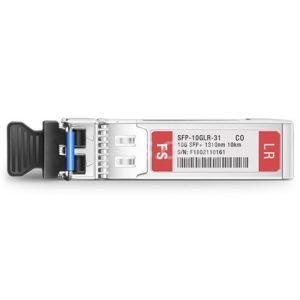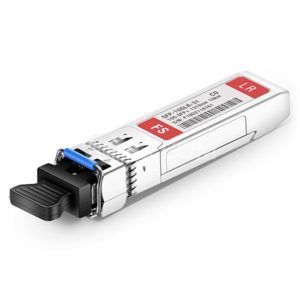As we all know, Cisco switches and fiber optic transceivers are considered as the benchmarks of the market. With the development of optical transceiver, Cisco has built a system to name each transceiver. For example, we often find Cisco C-class 10G transceiver like SFP-10G-LR. But there are S-class transceivers like SFP-10G-LR-S. You may be confused about their difference. That is why you should read this article. I will show you both of them and then make a comparison between SFP-10G-LR-S and SFP-10G-LR.
Basic Knowledge About SFP-10G-LR-S
SFP-10G-LR-S transceiver provides 10GBase-LR throughput up to 10 km over single mode fiber at a wavelength of 1310 nm using an LC duplex patch cable. SFP-10G-LR-S can be applied in enterprise and data center in which don’t require very long distance, temperature tolerances, or other special conditions. SFP-10G-LR-S can also support DOM which can help the administrator to monitor and make feedback of the operation of transceivers, including the temperature, the bias current of the laser diode and so on.
An Introduction of SFP-10G-LR
SFP-10G-LR transceiver is an LC duplex SFP+ transceiver for optical communications, rated for distances up to 10 km and a maximum bandwidth of 10Gbps. “LR” means long distance. The SFP-10G-LR transceiver operates at 1310nm wavelength. It can also support DOM, which is the same as SFP-10G-LR-S. DOM can provide more convenience for monitoring and operating as mentioned before.
SFP-10G-LR-S vs SFP-10G-LR
From their appearance and definition, SFP-10G-LR-S and SFP-10G-LR may be the same, but actually they have some differences in their protocols, temperatures and price.
SFP-10G-LR can support three protocols including Ethernet, OTN(Optical Transport Network) and WAN-PHY(Wide Area Network Physics). However, SFP-10G-LR-S can just support Ethernet protocol. In addition, SFP-10G-LR-S does not have TAA compliance.
SFP-10G-LR-S and SFP-10G-LR transceivers have different temperature ranges. But the operating temperature range of SFP-10G-LR-S is smaller, so SFP-10G-LR-S is better for shorter transmission distance applications than SFP-10G-LR. If you design a project for an enterprise or data center environment that does not need too long distance, temperature tolerances, or other special request, SFP-10G-LR-S should be just fine for you.
Compared with SFP-10G-LR, SFP-10G-LR-S doesn’t have too many specials. And the performance of SFP-10G-LR-S are no better than that of SFP-10G-LR. But why do so many people insist to select SFP-10G-LR-S? This is because SFP-10G-LR-S has lower prices.
Conclusion
From this this article, we know that SFP-10G-LR is different from SFP-10G-LR-S in the sides of protocols, temperature ranges and price. Except the C-class and S-class SFP+ transceivers introduced in this article, there are still SFP-10G-SR and SFP-10G-SR-S transceiver. You can visit FS.COM for more information and choose the one fit for your needs.

